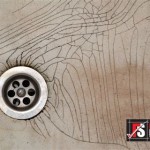Mold in Bathroom Sink Drain: Causes and Solutions
Bathrooms are prone to moisture and humidity, creating an ideal environment for mold growth. The bathroom sink drain is a common area where mold can accumulate, leading to an unsightly appearance, unpleasant odors, and potential health concerns.
Mold is a type of fungus that thrives in damp, dark places. In the bathroom, the sink drain is a warm and humid area, providing an ideal breeding ground for mold spores. These spores are often present in the air and can easily settle into the drain, especially if there is stagnant water or organic matter present.
Mold can appear in various colors, including black, green, white, or pink. If you notice a dark or discolored ring around the sink drain, it is likely mold growth. Mold can also produce a musty or earthy odor, which can be unpleasant and contribute to air quality issues.
To prevent mold growth in the bathroom sink drain, it is essential to keep the area clean and free of moisture. Regularly cleaning the drain with a commercial drain cleaner or a homemade solution of baking soda and vinegar can help remove any buildup of debris and prevent mold from forming.
Good ventilation is also crucial in preventing mold growth. If the bathroom has a window, open it frequently to allow fresh air to circulate and reduce humidity levels. If there is no window, consider installing an exhaust fan to extract moisture from the air.
If mold has already formed in the bathroom sink drain, it is important to address it promptly. Ignoring mold growth can lead to further spread and potential health concerns. To remove mold from the drain, use a non-toxic cleaner, such as white vinegar or a diluted bleach solution. Apply the cleaner to the affected area using a brush or cotton swab and allow it to sit for several minutes. Rinse thoroughly with hot water and repeat the process as necessary until the mold is removed.
To prevent future mold growth, it is recommended to regularly clean and disinfect the bathroom sink drain. A simple solution of baking soda and white vinegar can be used weekly or monthly to keep the drain free of debris and mold spores. Additionally, avoid leaving water standing in the sink for extended periods and ensure the bathroom is well-ventilated.
If the mold growth is extensive or if there is a persistent musty odor, it may be necessary to consult a professional mold remediation specialist. They can assess the situation, identify the source of the mold, and recommend the appropriate course of action to remove the mold and prevent its recurrence.

What Causes Black Mold In Sink Drains How To Get Rid Of It

5 Signs That You Have Mold Growing In Your Sink Drain

How To Clear The Black Slime From Your Bathroom Sink

How To Clean Mold In Bathroom Basin Youtube

From Gross To Clean How Get Rid Of Mold In Your Sink Drain Mr Kitchen Faucets

Remove Bathroom Mold And Prevent It From Returning

How To Remove Toxic Mold And Smell In Drain Pipes Safe Inspections

What Causes Black Mold In Sink Drains How To Remove It

Tips To Prevent Mold Growth In Common Plumbing Areas Around Your Home

What To Do When The Bathroom Sink Smells Like Mildew Mold Smell







